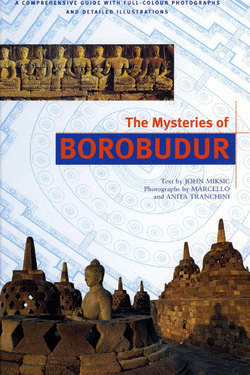Читать книгу Mysteries of Borobudur Discover Indonesia - John Miksic - Страница 6
На сайте Литреса книга снята с продажи.
ОглавлениеConstruction
It is impossible to calculate how much it cost the Javanese to build Borobudur in terms of labor and materials. Stone was plentiful and did not have to be transported far. The workmen probably used wooden carts to haul boulders from the nearby riverbed.
Geological and archaeological studies of the ground beneath Borobudur have shown that its foundation consists of a natural hill which was reshaped by ancient Javanese builders.
Construction at Borobudur probably began around AD 760 and seems to have been completed by about 830. Work was probably not always kept up at the same rate during this 70-year period, but proceeded in spurts. At some times, many men must have been employed, at others only a few, and activity seems to have ceased completely during certain periods.
At least one part of the monument collapsed during its construction. Perhaps other lesser setbacks also occurred. The original plan was simpler and required less labor, but plans for Borobudur changed several times and each new design necessitated more work.
Unskilled laborers performed most of the work during the early stages: hauling the stones, leveling the earth for the foundation, and terracing the hillside. The monument's stones each weigh about 100 kilograms. If one man with one cart could transport just one stone per day, it would have taken 100 men working every day about 30 years to haul one million of them up the site. Perhaps another 100 men would have been needed to load and unload the carts and hew the boulders into rectangular shapes. If, as seems likely, they worked during only half of the year, 200 men would have been required to accomplish each of these tasks.
The number of laborers needed to carve the statues and reliefs is more difficult to estimate. A modern craftsman can complete a large Buddha statue in about one month. Thus, a group of ten carvers, working at the same pace, could have completed the Buddha statues on Borobudur in about five years. Work on the reliefs was probably divided among several groups of sculptors. The masters first sketched the main outlines of the scenes, and their apprentices then did most of the rough work. The masters returned in the final stages to apply the finishing touches to the panels.
Unfortunately, the very last stage of construction is no longer visible except in minute traces. The stones we view today when we visit Borobudur were not meant to be seen at all, for the entire monument was originally coated with white plaster and then painted. The plasterwork would have required skill, for very fine details were molded using this medium. Borobudur would then have appeared not as a dark gray mass, but as a beacon of color hovering above the uniform green of the rice fields and coconut groves.
The entrance to the eastern stairway, leading from ground level to a walkway atop the stone encasement concealing the "hidden foot" of the monument.
These rough estimates suggest that Borobudur could have been built in about 30 years by a workforce of several hundred men working every day. In reality, the rhythm of work undoubtedly fluctuated seasonally to accommodate the agricultural cycle, and took 60 or more years to complete. The construction of Borobudur was a sizable task, and the achievement of the ancient Javanese is even more impressive when we consider that other temples were being built at the same time.
The majority of workers were farmers as well as part-time artisans who may have donated their labor to earn religious merit. Evidence from other temples suggests that each village contributed a group of men who formed a fixed unit within the overall labor force. Borobudur is impressive not merely on account of its sheer size, but because it shows how large a proportion of the Javanese population had creative talents.
An aerial view of Borobudur from the north. Visitors on the upper terrace cluster around a stupa containing the statue known as Kakek Bima, which is credited by the Javanese with special powers.
Religious authorities and architects probably supervised the daily activities, but the stimulus and material support must have come from the ruler himself.
